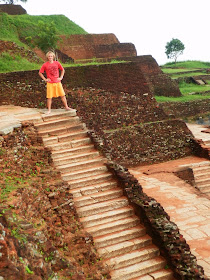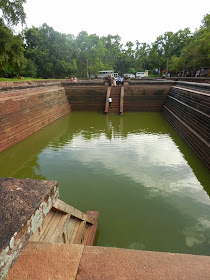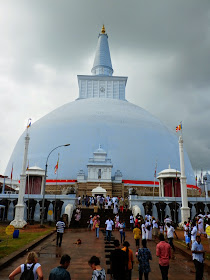To my surprise it was possible in Sri Lanka to detect the tracks of the similar prehistoric architectural style as I enjoyed in the megalithic ruins of Peru - walls laid of big polygonal stones. Anyway it should not be a surprise as this kind of ancient masonry is spread world-wide. Thus why not in ancient Lanka - the pearl of Asia, the real garden of Eden.
Memories of the Sacred Valley in Peru
Ollantaytambo
A double wall in Ollantaytambo - megaliths in one side and stone plates covering the opposite one
Machu Picchu
My favorite place Sacsayhuaman
Note how the hole of the missing stone of the right side is fixed with small rocks. The same in the left side wall as well or was there even a stone plate shielding the the small rocks.
By Cusco
The First Encounter - The First Capital - Anuradhapura
Usually just clay bricks or rectangular stones have been used for all of the buildings, from a temple to a pool.
King's baths. Nothing special with the pool.
But the fence surrounding the pools...
The famous temple. Just a big amazing dagoba.
The pavement in the temple is imitating the masonry of polygonal walls
Thiruketheeswaram
The temple has been there from the time immemorial. The buildings themselves are new. Nevertheless at the temple there were those strange huge rocks lying around. Those rocks have been recently brought from India from a temple to extend Thiruketheeswaram. So the questions arose:
are the rocks from the temple itself or at the temple?
are the stones freshly cut or ancient?
All of them of strange "unfinished" shape, not nice normal building blocks. A witness of the ancient way to use semi-natural blocks or modern raw blocks to be broken into suitable peaces at the site.
Some blocks had familiar polygonal features. That was not a surprise at all if to consider the stones ancient/old coming from a demolished temple not modern.
Surprising was that every stone has at least one edge carved. Usually many edges, up to all of the edges, were carved. I had not see that before. Were those the marks of little explosives to break the stone off from the bigger rock or the signs of ancient masonry.
Strange marks
Probably the stones really are from an actual temple as that kind of stones definitely won't come from a quarry
Sigiriya
The ruined Lion Gate on the top of the rock displayed the signs of possible polygonal masonry. The rocks themselves were lost but the sockets of the rocks resembled to the ones seen in Peru.
Sigiriya Lion Gate above and the probable counterpart in Ollantaytambo Peru below
A pool on top of a smaller rock on the way down and Mirjam - a firm rock and a passing tourist :-D
All passes. Even time passes. Sic transit gloria mundi!
All passes. Even time passes. Sic transit gloria mundi!
Just can not help but add this comparison as well:

Where and when?
Where and when?
Pollonnaruwa
In this place one could not detect buildings of a big rocks but clay brick walls are covered with stone plates to present the impression of ancient masonry
It is possible to see here in the wall how between the two layers of stone plates there is some mass of cement and stones
In the ruins there are also lying some stones of that kind - reminding the ones in Thiruketheeswaram.
A strange stone in its original position. So those holes must have served as some sort of socket to fix different building details to each other.
...

The Great Mystery





























No comments:
Post a Comment